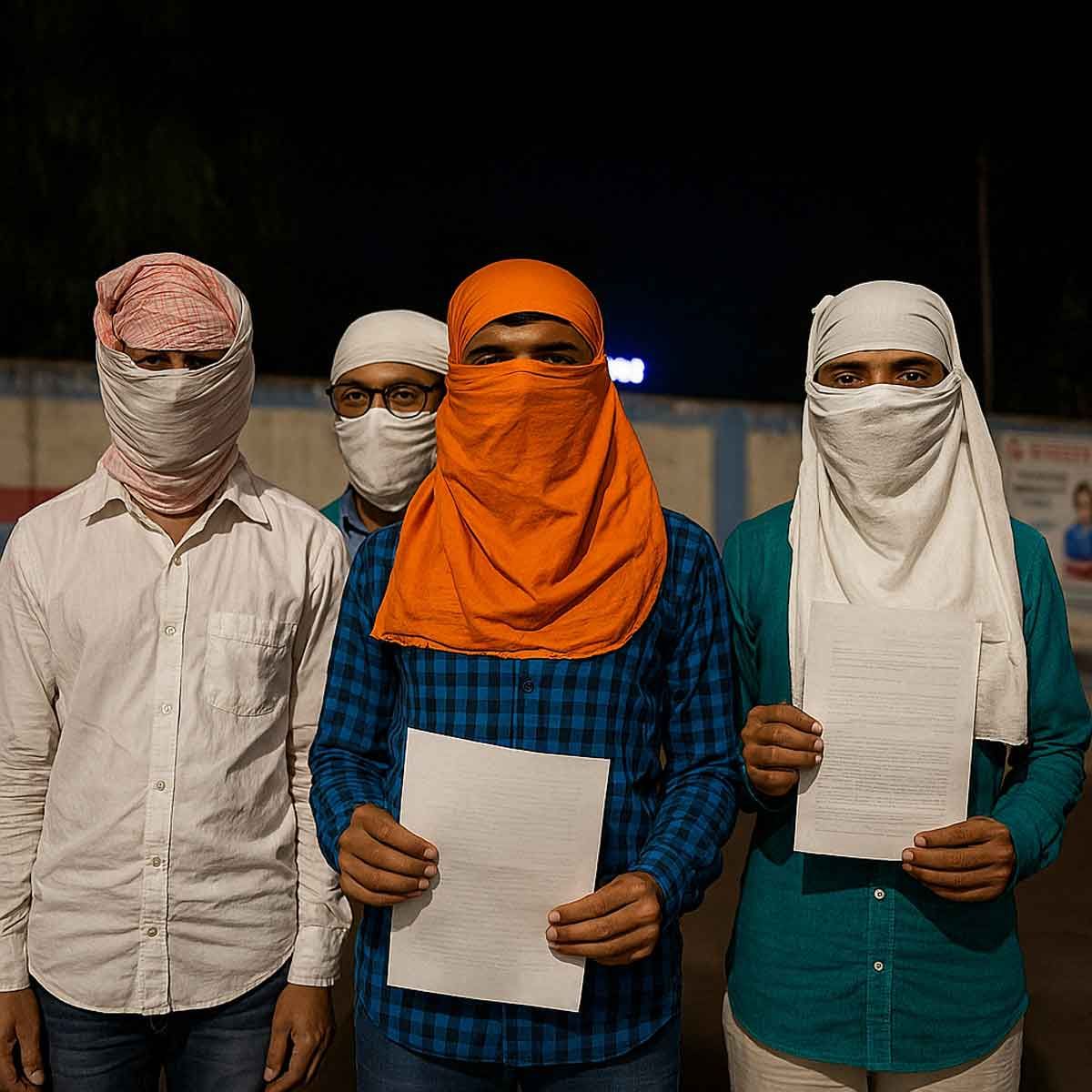More Coverage
Twitter Coverage
Satyaagrah
Written on
Satyaagrah
Written on
Satyaagrah
Written on
Satyaagrah
Written on
Satyaagrah
Written on
JOIN SATYAAGRAH SOCIAL MEDIA
"हस्ती मिटती नहीं हमारी": In a landmark victory, security forces finally dismantled Permili Dalam, a notorious Naxalite faction (PLGA) that terrorized Maharashtra's Gadchiroli for 39 years, running a parallel govt & even poisoning food supplies of jawans

Last week, the security forces finally completely destroyed the deadly Naxal terror group ‘Permili Dalam’ of the Peoples’ Liberation Guerrilla Army (PLGA) in the Gadchiroli area of Maharashtra. This group, long recognized as the logistical backbone for the Naxalite headquarters in Abujhmarh, met its end after decades of persistence and resistance. For 39 years, paramilitary and state police personnel engaged tirelessly in anti-Naxal operations before they could successfully dismantle this formidable group. The conclusion of this terror outfit represents the culmination of numerous sacrifices made by soldiers and officials dedicated to this cause.
On the 13th of May, security forces received critical information regarding the movement of some members of Permili Dalam in the Gadchiroli region. In response, the specialized C-60 squad, assembled specifically for combating Naxal operations, was promptly dispatched to the indicated area. As they conducted their search operation, the team was ambushed by Naxalite gunfire. However, the situation quickly turned as the security personnel engaged and neutralized three insurgents in retaliatory fire. Among those neutralized included two female combatants and a male Naxal identified as Commander Vasu. Notably, Commander Vasu was a significant figure within the group, carrying a bounty of Rs 22 lakh on his head due to his high profile within the organization. During the encounter, security forces also recovered a cache of weapons and materials, including a carbine, an INSAS rifle, an AK-47, and various pieces of Naxal literature and other pertinent items.
The relentless efforts of the security personnel have finally paid off with the dismantling of this notorious group, marking a pivotal victory in the long battle against Naxalite insurgencies. As a direct consequence of this success, the security forces have decisively advanced on Abujhmarh, which is widely recognized as the last stronghold and unofficial headquarters of the Naxalites. This strategic move came shortly after the group's collapse.
Moreover, Abujhmarh is unofficially known as the Naxalites’ headquarters and Permili Dalam was utilized as their supply-chain. This area has historically served as the central hub from which the Naxalites coordinated their operations and distributed resources essential for their activities throughout the region. The elimination of Permili Dalam, a key component in this logistics network, signifies a major disruption to the Naxalite infrastructure, severely impacting their ability to operate effectively. This achievement underscores the strategic importance of cutting off supply chains to cripple such insurgent groups and highlights the tactical acumen of the security forces in undermining the operational capabilities of the Naxalites.
What was Permili Dalam
Permili Dalam, a notorious Naxalite group, was established in 1985 by a group of educated Telugu youths. Over time, these founders became increasingly active in Gadchiroli, where they gradually built up the group's membership. This area soon became the central hub for Maoist activities, largely due to the group’s efforts since its inception. Permili Dalam was recognized as one of five key armed factions within the Dandakaranya zone, specifically under the Maoist South Gadchiroli division. Their early operations included intimidating officials from the forest department, marking the beginning of their violent campaign.
The group also worked to incite the local tribal populations against officers at nearby police stations. This was part of a broader strategy to spread Maoist ideology, aiming to disrupt the existing governmental structure and gain support from the indigenous communities. As Permili Dalam’s influence grew, so did its membership, which eventually included female fighters, reflecting a significant expansion in its cadre.
The conflict instigated by Permili Dalam persisted for nearly four decades, during which many soldiers and members of the security forces lost their lives. However, over the years, as Gadchiroli developed and the government launched various initiatives to improve living conditions in the region, many young people began distancing themselves from the Maoist group. They started to see the benefits of peace and governmental support over the violent struggle advocated by the Naxalites.
Ultimately, after 39 years of prolonged conflict and efforts by security forces, Permili Dalam was completely dismantled in a decisive operation against Naxalite terror. This marked the end of the group’s long-standing reign of violence and its influence in the Gadchiroli region, bringing a sense of relief and hope for a more peaceful future to the local communities.
How Permili Dalam Once Incited Fear
An officer from the paramilitary unit involved in anti-Naxal operations spoke with OpIndia under the condition of anonymity. He provided detailed insights into the operational tactics of Permili Dalam and other Naxal organizations. These groups had a strategic approach to select locations that were hidden from the administrative view, allowing them to carry out their activities with less interference. These areas often involved the depths of the forests where small groups of police and forest department employees were positioned and became prime targets for assaults. After securing control, the Naxalites declared these regions as their territories and claimed to establish a parallel government, asserting their dominance and rule over the area.
The officer further revealed that within the dense woodlands of Gadchiroli, Permili Dalam set up training camps. These camps were not just hideouts but active grounds where young tribal members were radicalized against the government. The indoctrination included military-style training where the tribals were taught how to handle and use firearms effectively, preparing them for armed conflict against the state.
Moreover, the Naxalites’ resource acquisition tactics included raiding mines in Jharkhand and Chhattisgarh. During these raids, they would steal detonators, which were then provided to groups like Permili Dalam. The use of these detonators was twofold: they were essential in building bombs and were strategically used in planting landmines, thereby increasing the lethality of their operations.
In a further attempt to conceal their activities and ensure the safety of their arsenal, Permili Dalam, along with other Naxalite groups, resorted to burying their weapons in water tanks. This method of hiding their arms was crucial in evading detection by law enforcement agencies and maintaining a continuous supply of weapons for their operations.
A Central Reserve Police Force (CRPF) officer involved in the anti-Naxal operations shared insights into the operational strategies and ambitions of Permili Dalam. This group, he explained, follows the Maoist doctrine, a framework that advocates the eradication of adversaries in every possible form. It was disclosed that Permili Dalam not only engaged in direct combat with security forces but also devised methods to sabotage their essential supplies by contaminating food and water. The officer expressed optimism about the future, emphasizing that the relentless continuation of such operations could lead to the eradication of Naxal influences from India.
Why Abujhmarh was made the headquarters
Further insights were provided by another CRPF officer who discussed why Abujhmarh was chosen as a strategic location by the Naxalites. He noted that the name Abujhmarh translates to "something that nobody could comprehend," reflecting the area's mysterious and complex nature. Covering an expanse of 4,400 square kilometers, the forest has not been fully mapped, which adds to its strategic ambiguity. Operations within this area require the governor's approval, indicating the sensitivity and restricted access to this region. The officer also mentioned that the geographical placement of Abujhmarh, straddling multiple state borders, occasionally gave the Naxalites tactical advantages during police border disputes. The forest's location, divided between Maharashtra and Andhra Pradesh, provides a unique strategic benefit for covert operations and as a stronghold.
 |
 Support Us
Support Us
Satyagraha was born from the heart of our land, with an undying aim to unveil the true essence of Bharat. It seeks to illuminate the hidden tales of our valiant freedom fighters and the rich chronicles that haven't yet sung their complete melody in the mainstream.
While platforms like NDTV and 'The Wire' effortlessly garner funds under the banner of safeguarding democracy, we at Satyagraha walk a different path. Our strength and resonance come from you. In this journey to weave a stronger Bharat, every little contribution amplifies our voice. Let's come together, contribute as you can, and champion the true spirit of our nation.
 |  |  |
| ICICI Bank of Satyaagrah | Razorpay Bank of Satyaagrah | PayPal Bank of Satyaagrah - For International Payments |
If all above doesn't work, then try the LINK below:
Please share the article on other platforms
DISCLAIMER: The author is solely responsible for the views expressed in this article. The author carries the responsibility for citing and/or licensing of images utilized within the text. The website also frequently uses non-commercial images for representational purposes only in line with the article. We are not responsible for the authenticity of such images. If some images have a copyright issue, we request the person/entity to contact us at This email address is being protected from spambots. You need JavaScript enabled to view it. and we will take the necessary actions to resolve the issue.
Related Articles
- "Taste the spirit of resilience and reform": Yerawada's 'Shrunkhala Uphar Gruh' isn't just a restaurant, run by inmates, it symbolizes hope and reform, a meal here is a nod to second chances, showcasing Maharashtra's progressive corrections approach
- In Mumbai, Mihir Shah and family members, including his mother and sisters arrested after a devastating BMW hit-and-run that killed Kaveri Nakhwa, who was tragically dragged 2 km; her body horrifically run over again before the culprits fled the scene
- "दिलजले": Love Jihad in Uran, 22-year-old Yashashree Shinde was brutally murdered by Dawood Sheikh, her decomposed body found with severe mutilation of genitals & face near the Uran-Panvel railway line; Sheikh arrested at the Maharashtra-Karnataka border
- "News is the first rough draft of history": In an absolutely thrilling announcement, Eknath Shinde Govt renames the Versova–Bandra Sea Link as Veer Savarkar Setu and Mumbai Trans Harbour Link as Atal Bihari Vajpayee Smruti Nhava Sheva Atal Setu
- "This is the battle of ideology, this is battle of Hindutva": In a big twist of political turmoil in Maharashtra, Fadnavis declareed Eknath Shinde will be the next Chief Minister of Maharashtra, swearing-in will be at Raj Bhavan in Mumbai today evening
- "शुकराना": Maharashtra CM Eknath Shinde orders the removal of 156 illegal encroachments from Vishalgadh Fort, including 35 shops, following protests led by Sambhajiraje, underscoring reported historical insults to Hindu heritage by the Muslims in Kolhapur
- Raj Thackeray roared today at the ‘Uttarsabha rally ‘ while rebutting counter-allegations against him made by Maha-Vikas-Aghadi leaders: He spoke fiercely demanding UCC, unequivocally supported Hindutva, and lashed out at MVA leaders
- Plea of MP Navneet Rana and husband MLA Ravi Rana to quash FIR for the gruesome and heinous crime of reciting Hanuman Chalisa outside Matoshree dismissed by Bombay HC: Justices stated that it was devoid of merit
- Maharashtra: Narendra Sriram brutally assaulted by Islamists mob for sharing Whatsapp story on social media in support of ex-BJP spokesperson Nupur Sharma, Nisar Sayyad, Nouhid, Wasim Pathan, Altaf Shaikh, and six others booked
- "आखरी सांस": In a historic anti-Naxal operation near the Odisha-Chhattisgarh border, 16 Maoists, including Jairam alias Chalpati with a Rs 1 crore bounty, were killed, weapons like AK-47s seized, and security boosted, with leaders praising the forces
- NCP leader Baba Siddique shot dead in Mumbai ahead of the Maharashtra elections, two suspects detained; he was known for his Iftar parties that reconciled Salman and Shah Rukh Khan, and his son Zeeshan won Bandra East before being expelled from Congress
- Prima facie evidence found that Nawab Malik conspired with D company members Hasina Parkar, Salim Patel, and Sardar Khan to grab property, directly and deliberately involved in money laundering’: Says Mumbai court
- "Apni takdeer khud hi likhni hogi, ye koi chitthi nahi… jo dusron se likhwa loge": Uddhav Thackeray to lose the party now after losing the state, EC ordered Eknath Shinde and Uddhav to prove their majority with support of MLAs and MPs in Shiv Sena
- "ग़ुरूर-ओ-क़हर तलाक़": In a shocking twist, Kalyan's Sohail Shaikh gave triple talaq to his wife for refusing ₹15 lakh demands and sleeping with his boss, abusing her brutally, now facing charges under the 2019 Talaq Law and Bharatiya Nyaya Sanhita
- "Huge setback to Uddhav Thackeray": Rebel Eknath Shinde camp asserted that it is real Shiv Sena, claims stake on Shiv Sena party symbol and may avoid anti-defection law if it holds true, on the verge of successfully charting out from Shiv Sena




























